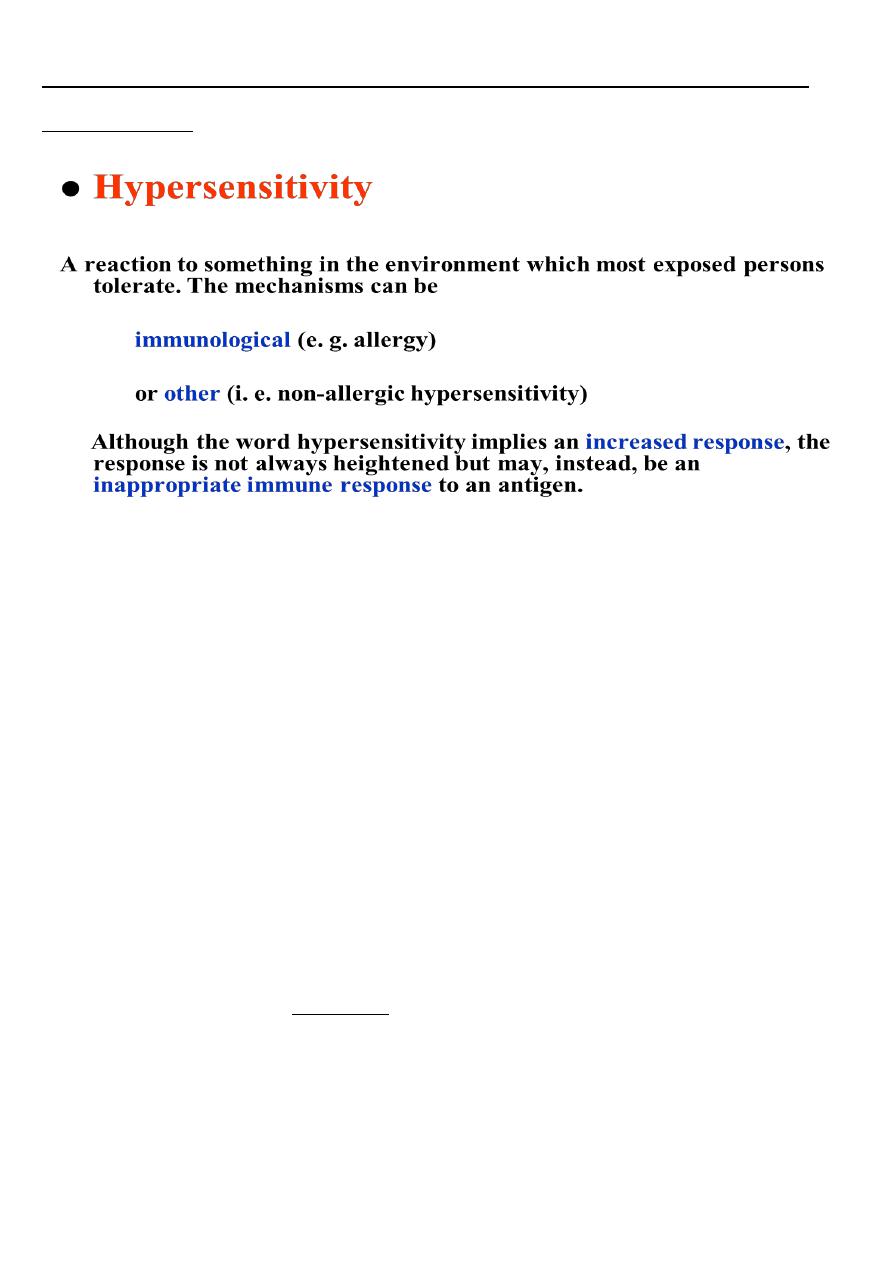
Clinical immunologyL-6 Dr. fadil
Allergic disorders
Atopy – a hereditary predisposition to the development of immediat hypersensitivity
reactions against common environmental antigens with tendency to produce IgE antibodies to
extremely small amounts of naturally occuring allergens.
The abnormal IgE response of atopic individuals is at least part genetic – it often runs in
families.
Atopic individuals have abnormally high levels of circulating IgE and also more than normal
numbers of circulating eosinophils.
These individuals are more susceptible to allergies such as hay fever, eczema and asthma.
Allergy – is a reaction of hypersensitivity mediated by immunologic mechanisms
Allergic reactions may develop in the course of either humoral or cell-mediated response
Allergen refers specifically to nonparasitic antigen capable of stimulating type I hypersensitive
responses in allergic individuals.
IgE-mediated Inflammation :Early Phase
Time course: Minutes after antigen challenge
Example: Acute asthma
Cause: Mediators released by cells attracted to area of inflammation
Cells involved: Mast cells, basophils

IgE-mediated Inflammation: Late Phase
Time course: Hours after antigen challenge
Example: Chronic asthma
Cause: Mediators released by cells attracted to area of inflammation during and after the early
phase
Cells involved: Eosinophils, Basophils Neutrophils, Lymphocytes
IgE Production
Dependent on a TH-2 immune response
Presence of IL-4, IL-5, IL-9, IL-13 favor a TH-2 response
IL-10 suppresses a TH-1 response, high levels also suppresses a TH-2 response
Th1& Th2 responses
Cytokines can be functionally divided into two groups:
• Those that are pro-inflammatory& those that are essentially anti-inflammatory but that
promote allergic responses.
• T lymphocytes are major sources of cytokines.
• T helper cells can be subdivided into Th1& Th2.
Th1-type cytokines tend to produce the pro-inflammatory response that responsible for killing
intracellular parasites& perpetuating auto-immune responses. The main cytokine here is
gamma interferon.
Excessive pro-inflammatory responses can lead to uncontrolled tissue damage, so there needs
to be a mechanism to counteract this.
The Th2 type cytokines include interleukins 4, 5,& 13 which are associated with promotion of
IgE& eosinophilic responses in atopy,& also IL-10 which has more anti inflammatory response.
Therefore, human should have a balanced Th1& Th2 response to maintain a balanced immune
process. Many authors regard allergy as a Th2 weighted imbalance.
Allergic reactions are sensitivities to substances called allergens that come into contact with
the skin, nose, eye, respiratory tract and gastrointestinal tract. They can be breathed into the
lungs, swallowed or injected.

Many allergic reactions are mild, while others can be severs and life-threatening. They can be
confined to small area of the body. The most severe form called anaphylaxis or anaphylactic
shock. Allergic reactions occur more often in people who have a family history of allergies.
Individuals without atopic background also may develop hypersensitivity reactions particularly
urticaria &anaphylaxis associated with same class of antibody, IgE that found in atopic
individuals.
Therefore the term diseases of immediate hypersensitivity reactions(DIHR) presents a more
reliable term than the broad term atopy or allergy.
Allergic diseases are common &increasing cause of illness, affecting between 15%&20% of the
population at some time.
In an allergic diseases, initial exposure to an otherwise harmless exogenous substance (or
allergen) triggers the production of specific IgE ab., by activated B-lymphocytes .
Long standing or recurrent allergic inflammation may give rise to a chronic inflammatory
response characterized by a complex infiltration of macrophages, eosinophils &T-lymphocytes,
in addition to mast cells & basophils.
At this stage inhibition of mast cells mediators with antihistamines is clinically ineffective.
Factors influencing susceptibility to allergic diseases
1-unexplained(idiopathic)
2-hygeine hypothesis :
Observation (one of a number of examples) – Children raised in rural areas close to animals
and exposed to endotoxin in dust have a lower incidence of atopic disease
Theory – Endotoxin influences the cytokines that APC’s secrete as they present antigen so as
to favor a Th1 instead of a Th2 response
3-family history. Individuals with history of allergy can have family members with similar
allergic disorder.
4-genetic hypothesis: genes controlling cytokine production & IgE levels
5- environmental factors: pollutants, cigarettes smoking, bacterial &viral infection.
The fixation of IgE to human mast cells &basophils, a process termed sensitization, prepares
these cells for subsequent antigen- specific activation.

DIHR
1-urticaria
2-angioedema
3-atopic dermatitis
4-allergic dermatitis
5-allergic rhinitis
6-bronchial asthma
7-food allergy
8-drug allergy
9-insect venom allergy
10-anaphylaxis
Investigations
1-skin prick test:
Gold standard of allergy testing. Diluted standardized allergen solution is placed on the
forearm &the skin is punctured through the droplet.
After 10 minutes a positive response is indicated by a local wheal & flare response > 2 mm
larger than negative control.
2-specific IgE tests: quantity of IgE directed against the putative allergen.
3-chalenge test: bronchial provocation testing, nasal challenge& food challenge for
occupational asthma &food allergy.
4- blood testing: peripheral eosinophilia, however, absolute eosinophilia or eosinophils >20%
should be searched for non-atopic cause.
Management
1-the first & the most important line of management is the avoidance of allergens: like
food, drugs or other pollution.
2-antihistamines: block histamine H-1 receptors release thereby inhibit histamine release.
3-corticosteroids: down-regulate pro-inflammatory cytokine production. They are highly
effective drugs, but carry a high risk because of side effects.

4-sodium cromoglycate: stabilizes the mast cell membrane &inhibits the release of
vasoactive mediators. It is ineffective in the management of food allergy.
5- antigen specific immunotherapy: sequential administration of dilute antigen (allergen)
over a prolonged period of time. This process is termed desensitization.
This treatment option is valid for IgE- mediated allergic diseases such as allergic rhinitis,
food allergies, insect stings allergy & drug allergy. It is highly effective but carries the risk of
anaphylaxis.
6-Omalizumab: a monoclonal antibody against IgE, inhibits the binding of IgE to mast cells
& basophils.
7- adrenaline (epinephrine) may be life saving in the acute management of anaphylaxis.
Allergic rhinitis
The most common atopic disorder, affecting 10-20% of populations is allergic rhinitis,
commonly known as hay fever
This results from the reaction of airborne allergens with sensitized mast cells in the
conjunctivae and nasal mucosa to induce the release of pharmacologically active mediators
from mast cells; these mediators then cause localized vasodilation and increased capillary
permeability
The symptoms include watery exudation of the conjunctivae, nasal mucosa, and upper
respiratory tract, as wll as sneezing and coughing
In 50% patients with rhinitis can develop asthma = conception one airway – one disease
Bronchial asthma - definition
➢ Asthma is a chronic inflammatory disorder of the airways in which many cells and
cellular elements play a role.
➢ The chronic inflammation causes an associated increase in airway hyperresponsiveness
that leads to recurrent episodes of wheezing, breathlessness, chest tightness, and
coughing, particularly at night or in the early morning.
➢ These episodes are usually associated with widespread but variable airway obstruction
that is often reversible either spontaneously or with treatment.
Etiology
➢ *atopy and allergy
➢ * genetic factors:

➢ genes, in combination with environmental factors, may turn out to play a key role in
the development of asthma.
* environmental factors:
➢ early childhood exposure to allergens and maternal smoking has a major influence on
IgE production.
bronchial hyper responsiveness (BHR) is demonstrated by asking the patient to inhale
gradually increasing concentration of either histamine or methacholin ( bronchial
provocation test).
Clinical features:
Typical symptoms include wheeze ,breathlessness ,chest tightness, & cough in response to
cold air, exercise, airborne allergens or viral respiratory tract infections.
• Intermittent asthma: patients are asymptomatic between exacerbations .
• Persistent asthma: the pattern is one of chronic wheeze &breathlessness.
• -Nocturnal asthma :symptoms are mainly at night.
• -Cough variant asthma: cough without dyspnea.
• Occupational asthma: accounts for 5% of adult onset asthma.
• Early onset asthma: asthma in early childhood.
• Late onset asthma: asthma in adulthood.
Some patients have asthma after the use of B-blockers &aspirin (NSAIDs) (10% of patients).
This is due to a shift in metabolism of arachidonic acid from cyclooxygenase (generating
PGs) to lipo-oxygenase (generating leukotrienes).
Therefore, the best treatment is by using of leukotriene- receptor antagonists such as
monteleukast.
" Age doesn’t equal wisdom "
